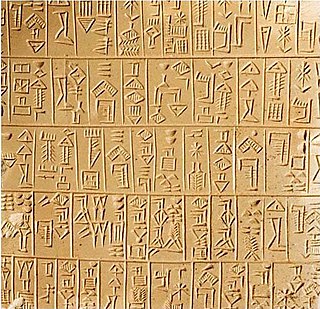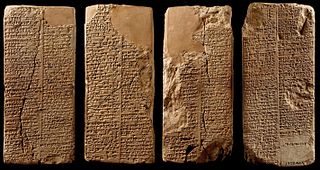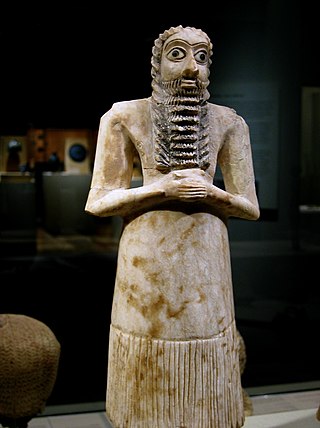Related Research Articles

Sumerian is the language of ancient Sumer. It is one of the oldest attested languages, dating back to at least 2900 BC. It is accepted to be a local language isolate and to have been spoken in ancient Mesopotamia, in the area that is modern-day Iraq.

A flood myth or a deluge myth is a myth in which a great flood, usually sent by a deity or deities, destroys civilization, often in an act of divine retribution. Parallels are often drawn between the flood waters of these myths and the primaeval waters which appear in certain creation myths, as the flood waters are described as a measure for the cleansing of humanity, in preparation for rebirth. Most flood myths also contain a culture hero, who "represents the human craving for life".

Atra-Hasis is an 18th-century BCE Akkadian epic, recorded in various versions on clay tablets, named for its protagonist, Atrahasis. The Atra-Hasis tablets include both a creation myth and one of three surviving Babylonian flood myths. The name "Atra-Hasis" also appears, as king of Shuruppak in the times before a flood, on one of the Sumerian King Lists.
Kubaba was a legendary Mesopotamian queen who according to the Sumerian King List ruled over Kish for a hundred years before the rise of the dynasty of Akshak. It is typically assumed that she was not a historical figure.

The Lament for Ur, or Lamentation over the city of Ur is a Sumerian lament composed around the time of the fall of Ur to the Elamites and the end of the city's third dynasty.

É is the Sumerian word or symbol for house or temple.
Eleanor Robson, is a British Assyriologist and academic. She is Professor of Ancient Middle Eastern History at University College London. She is a former chair of the British Institute for the Study of Iraq and a Quondam fellow of All Souls College, Oxford. She is a Fellow of the British Academy.

Ubara-tutu of Shuruppak was the last antediluvian king of Sumer, according to some versions of the Sumerian King List. He was said to have reigned for 18,600 years. He was the son of En-men-dur-ana, a Sumerian mythological figure often compared to Enoch, as he entered heaven without dying. Ubara-Tutu was the king of Sumer until a flood swept over his land.
The earliest record of a Sumerian creation myth, called The Eridu Genesis by historian Thorkild Jacobsen, is found on a single fragmentary tablet excavated in Nippur by the Expedition of the University of Pennsylvania in 1893, and first recognized by Arno Poebel in 1912. It is written in the Sumerian language and dated to around 1600 BCE. Other Sumerian creation myths from around this date are called the Barton Cylinder, the Debate between sheep and grain and the Debate between Winter and Summer, also found at Nippur.

En-sipad-zid-ana appears as the second king of Larak in some versions of the Sumerian King List (SKL). According to that literary composition, En-sipad-zid-ana ruled for 28,800 years. The kings on the early part of the SKL are usually not considered historical, except when they are mentioned in Early Dynastic documents. En-sipad-zid-ana is not one of them.

The Gudea cylinders are a pair of terracotta cylinders dating to c. 2125 BC, on which is written in cuneiform a Sumerian myth called the Building of Ningirsu's temple. The cylinders were made by Gudea, the ruler of Lagash, and were found in 1877 during excavations at Telloh, Iraq and are now displayed in the Louvre in Paris, France. They are the largest cuneiform cylinders yet discovered and contain the longest known text written in the Sumerian language.

The "Debate between sheep and grain" or "Myth of cattle and grain" is a Sumerian creation myth, written on clay tablets in the mid to late 3rd millennium BC.

The Debate between Winter and Summer or Myth of Emesh and Enten is a Sumerian creation myth, written on clay tablets in the mid to late 3rd millennium BC.

Enlil and Ninlil or the Myth of Enlil and Ninlil or Enlil and Ninlil: The begetting of Nanna is a Sumerian creation myth, written on clay tablets in the mid to late 3rd millennium BC.

The Kesh temple hymn, Liturgy to Nintud, or Liturgy to Nintud on the creation of man and woman, is a Sumerian tablet, written on clay tablets as early as 2600 BCE. Along with the Instructions of Shuruppak, it is the oldest surviving literature in the world.

The Hymn to Enlil, Enlil and the Ekur (Enlil A), Hymn to the Ekur, Hymn and incantation to Enlil, Hymn to Enlil the all beneficent or Excerpt from an exorcism is a Sumerian myth, written on clay tablets in the late third millennium BC.

The Electronic Text Corpus of Sumerian Literature (ETCSL) was a project that provides an online digital library of texts and translations of Sumerian literature.

The Song of the hoe or the Creation of the pickax is a Sumerian creation myth, written on clay tablets from the last century of the 3rd millennium BCE.
Edin is a toponym featured on the Gudea cylinders as a watercourse from which plaster is taken to build a temple for Ningirsu:
Clay plaster, harmoniously blended clay taken from the Edin canal, has been chosen by Lord Ningirsu with his holy heart, and was painted by Gudea with the splendors of heaven, as if kohl were being poured all over it.

Sharur, which means "smasher of thousands" is the weapon and symbol of the god Ninurta. Sumerian mythic sources describe it as an enchanted talking mace. It has been suggested as a possible precursor for similar objects in other mythology such as Arthurian lore.
References
- ↑ wordpress citing (1963)Kramer's : Sumerian Mythology & Black & Green's : God's Demons and Symbols of Ancient Mesopotamia / retrieved 09:27 15.10.11
- ↑ translation of Sumerian-Copyright © J.A. Black, G. Cunningham, E. Robson, and G. Zólyomi 1998, 1999, 2000; J.A. Black, G. Cunningham, E. Flückiger-hawker, E. Robson, J. Taylor, and G. Zólyomi 2001. The authors have asserted their moral rights. retrieved 10:51 15.10.11
- ↑ Mesopotamian cosmic geography by Wayne Horowitz page .315 (1998 retrieved 09:17 15.10.11)
- ↑ gateways to babylon.com website citing Black, J.A., Cunningham, G., Robson, E., and Zólyomi, G., [The Electronic Text Corpus of Sumerian Literature /, Oxford 1998 retrieved here10:41 15.10.11
- 1 2 "E. Jan Wilson (author) at the Neal A.Maxwell Institute,Brigham Young University (Copyright 2011)" . Retrieved 2011-10-15.
- ↑ Creation stories of the Middle East by Ewa Wasilewska page .89 (2000 retrieved 09:29 15.10.11)
- ↑ Journal article by T.M. Sharlach; The Journal of the American Oriental Society, Vol. 124, 2004 retrieved 11:35 15.10.11
- ↑ K. Schmidt: Sie bauten die ersten Tempel. Das rätselhafte Heiligtum der Steinzeitjäger. Verlag C.H. Beck, München 2006 ISBN 3-406-53500-3. retrieved 11:52 15.10.11
- ↑ The Anunna in the Sumerian Tradition A. Falkenstein (translated by K.E. Berry) page 131. Retrieved 15.10.11